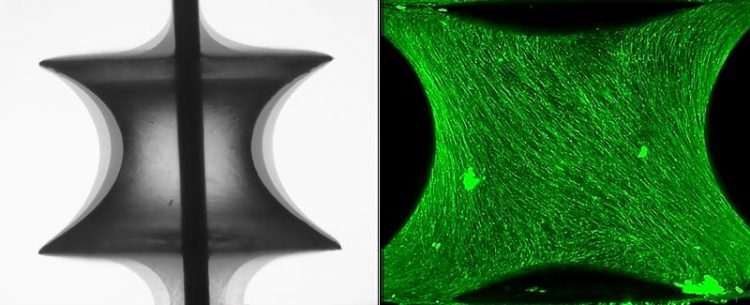Form is function

Composition of phase contrast images of a tissue grown on a capillary bridge (left). Skeleton of cells stained with a green fluorescent marker to visualize them in 3D, light-sheet microscopy (right). MPI of Colloids and Interfaces/ Sebastian Ehrig
Researchers at the Max Planck Institute of Colloids and Interfaces in Potsdam have shown that growing bone tissue behaves like a viscous liquid on long time scales, thereby accepting forms with minimal surface area. This cell behavior determines the shape of the tissue when it grows on a scaffold.
A particular strength and fascinating feature of living systems is their adaptability to changing environmental conditions. One such example being human bone which regularly regenerates itself by attaching and removing small bone packages.
This conversion process is regulated by the mechanical environment, allowing bone to adapt its structure and its internal shape to changing loading requirements such as regular exercise. John Dunlop, former group leader at the Max Planck Institute of Colloids and Interfaces in Potsdam, and now Professor of Biophysics at the University of Salzburg was researching with his team the optimum conditions for generating bone tissue.
Biological structures are formed by cells, which are much smaller than the resulting shape. The cells are even able to sense the curvature of a surface that is much larger than themselves. How do the cells manage to create such complex macroscopic forms or restore the original shape during bone healing?
“A partial answer to this question could be the insight of this work. Cells use surface energy for shaping in much the same way that complex structures can arise from soap bubbles due to surface energy,” underlines Peter Fratzl, Director at the Max Planck Institute of Colloids and Interfaces and co-author of the study, in which also scientists from the Berlin Charité, from Würzburg, from Dresden and from the Montanuniversität Leoben were involved.
Forms of constant mean curvature
The researchers were able to show that tissue that grew on curved surfaces developed forms with outer boundaries of constant mean curvature. These structures are very similar to forms of liquid droplets that assume a minimal surface area. Curved plastic surfaces functioned as substrates for cell and tissue growth, which Sebastian Ehrig produced during his PhD.
These surfaces were produced using a liquid polymer that solidified at high temperatures. It formed together with the substrate and different geometries on which the cells could grow and form new tissue. The amount of tissue formed depended on the shape of the substrate. The scientists noted that more tissue on strongly concave surfaces developed, indicating a mechanically induced biological feedback mechanism.
By inhibiting cell contractility it was shown that active cell forces are needed to produce sufficient surface tensions for fluid-like behavior and growth of the tissue. “This suggests that mechanical signal transduction between cells and their physical environment, along with the continuous reorganization of cells and matrix, is a key principle in tissue formation,” emphasizes Sebastian Ehrig, first author and former PhD student at the MPI of Colloids and Interfaces, who is now researching at the Max-Delbrück Center in Berlin.
Chiral Structures
Furthermore light sheet microscopy provided insights into the spatial structure of the tissue, with another notable discovery: the cells clustered into extensive chiral structures that spiral around the capillary bridges. You find similar structures in osteons, the smallest functional unit of the bone. An osteon arises when bone-forming cells (osteoblasts) are concentrically stored in 4-20 layers around a blood vessel, become walled and become lamellar bones.
The study suggests that liquid-like tissue behavior is a key principle for the formation of structures in biological systems. This could have far-reaching importance in terms of understanding healing processes and organ development but also for medical applications such as the development of implants.
S. Ehrig, B. Schamberger, C. M. Bidan, A. West, C. Jacobi, K. Lam, P. Kollmannsberger, A. Petersen, P. Tomancak, K. Kommareddy, F. D. Fischer, P. Fratzl, John W. C. Dunlop
Surface tension determines tissue shape and growth kinetics
Sci. Adv. 2019; 5: eaav9394
http://www.mpikg.mpg.de/6167246/news_publication_13873017_transferred
Media Contact
All latest news from the category: Life Sciences and Chemistry
Articles and reports from the Life Sciences and chemistry area deal with applied and basic research into modern biology, chemistry and human medicine.
Valuable information can be found on a range of life sciences fields including bacteriology, biochemistry, bionics, bioinformatics, biophysics, biotechnology, genetics, geobotany, human biology, marine biology, microbiology, molecular biology, cellular biology, zoology, bioinorganic chemistry, microchemistry and environmental chemistry.
Newest articles

First-of-its-kind study uses remote sensing to monitor plastic debris in rivers and lakes
Remote sensing creates a cost-effective solution to monitoring plastic pollution. A first-of-its-kind study from researchers at the University of Minnesota Twin Cities shows how remote sensing can help monitor and…

Laser-based artificial neuron mimics nerve cell functions at lightning speed
With a processing speed a billion times faster than nature, chip-based laser neuron could help advance AI tasks such as pattern recognition and sequence prediction. Researchers have developed a laser-based…

Optimising the processing of plastic waste
Just one look in the yellow bin reveals a colourful jumble of different types of plastic. However, the purer and more uniform plastic waste is, the easier it is to…



